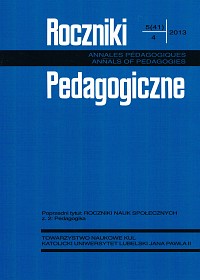Sexual Identity in Women at the Threshold of their Adulthood
Main Article Content
Abstract
Sexual identity is one of the dimensions of a man's identity. In literature we find numerous descriptions and definitions of it. Sexual identity is understood as a psychological phenomenon that is based on the relatively stable biological gender. Generally, sexual identity may be defined as an individual's knowledge about his/her belonging to a defined sexual group. Sexual identity can be characterized by means of models. A one-factor and a multi-factor model may be distinguished.
For the present article Sandra Bem's two-factor model of sexual identity is significant. The model assumes that there are patterns of sex and that sexes differ in biological, psychological and social-cultural dimensions. Because of the number of masculine and feminine traits the model singles out the following persons: sexually defined, androgynous, sexually undifferentiated, and cross-defined ones. The model was used in empirical studies. On the basis of the obtained data the following conclusions were formulated: 1. Feminine women are the greatest group; 2. The second most numerous group is the group of androgynous women; 3. The least group is constituted by women with an undefined sense of sexual identity; 4. Women that are characterized by a greater percentage of masculine traits more often tend to be active in fields socially considered as typical of men.
Article Details
References
Bokszański Z.: Tożsamość, w: Encyklopedia socjologii, red. H. Domański, W. Morawski, J. Mucha [i in.], t. IV, Warszawa: Oficyna Naukowa 2002.
Brzezińska A.: Społeczna psychologia rozwoju, t. III, Warszawa: Scholar 2000.
Colman A.M.: Słownik psychologii, Warszawa: Wydawnictwo Naukowe PWN 2009.
Cross S.E., Markus H.R.: Płeć w myśleniu, przekonaniach i działaniu: podejście poznawcze, w: Kobiety i mężczyźni: odmienne spojrzenie na różnice, red. B. Wojciszke, Gdańsk: GWP 2002.
Jedlikowska D.: Tożsamość jako somatyzacja, w: Idee i myśliciele. Tożsamość, podmiot, komunikowanie. Prace Katedry Kulturoznawstwa i Filozofii Wydziału Humanistycznego Akademii Górniczo-Hutniczej, t. XI, red. I.S. Fiut, Kraków: Wydawnictwo AGH 2009.
Mandal E.: Kobiecość i męskość w psychologii, w: Tożsamość społeczno-kulturowa płci, red. A. Barska, E. Mandal, Opole: Wydawnictwo Uniwersytetu Opolskiego 2003.
Martin C. L.: Płeć/płeć psychiczna (gender), w: Encyklopedia Blackwella. Psychologia społeczna, red. A.S.R. Mansteead, M. Hewstone, Warszawa: Jacek Santorski 1995.
Mikołajczyk M.: Cele życiowe licealistów i studentów w zależności od reaktywności i płci, „Psychologia Wychowawcza” 40(1996), nr 1.
Miluska J.: Tożsamość kobiet i mężczyzn w cyklu życia, Poznań: Wydawnictwo Naukowe UAM 1996.
Nikitorowicz J.: Młodzież pogranicza kulturowego Polski, Białorusi i Ukrainy wobec integracji europejskiej. Tożsamość, plany życiowe, wartości, Białystok: Trans Humana 2000.
Reber A.S., Reber E.S.: Słownik psychologii, wyd. IV, Warszawa: Wydawnictwo Naukowe Scholar 2005.
Reber A.S.: Tożsamość, w: Słownik psychologii, Warszawa: Wydawnictwo Naukowe Scholar 2002.
Sekuła-Kwaśniewicz H.: Płeć, w: Encyklopedia socjologii, red. H. Domański, W. Morawski, J. Mucha [i in.], t. III, Warszawa: Oficyna Naukowa 2000.
Strelau J.: Psychologia. Podręcznik akademicki, t. III: Jednostka w społeczeństwie i elementy psychologii stosowanej, Gdańsk: GWP 2000.
Wosińska W.: Płeć a zachowania społeczne, w: Encyklopedia psychologii, red. W. Szewczuk, Warszawa: Wydawnictwo Fundacji Innowacja 1998.
http://www.eid.edu.pl/archiwum/2002,100/luty,176/trudnosci_w_osiaganiu_tozsamosci_plciowej,1247.html [dostęp: 13 grudnia 2009].
http://www.pismo.niebieskalinia.pl/index.php?id=310 [dostęp: 13 grudnia 2009].
http://www.eid.edu.pl/archiwum/2002,100/luty,176/trudnosci_w_osiaganiu_tozsamosci_plciowej,1247.html [dostęp: 13 grudnia 2009].
